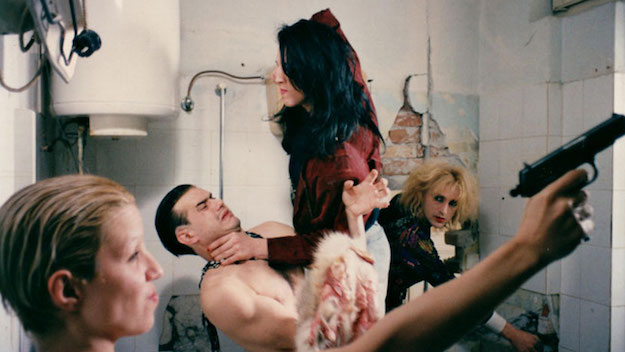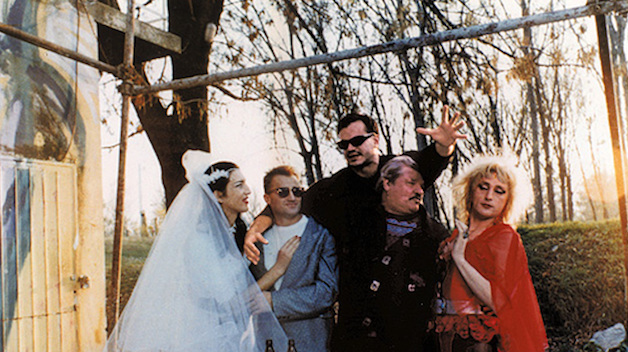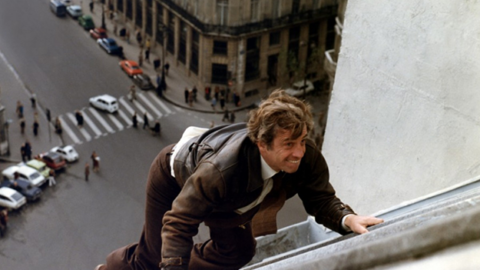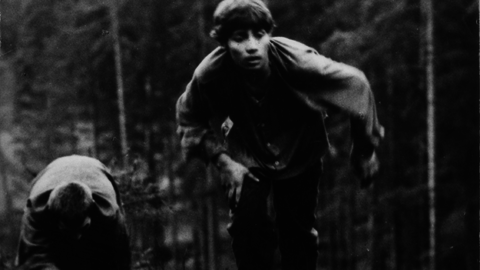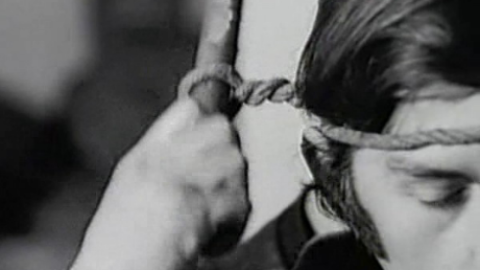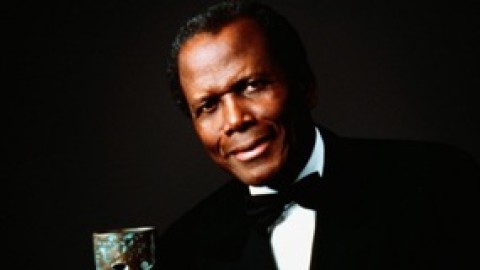Berlin Interview: Želimir Žilnik
A relentless rebel of Serbian cinema and one of the major figures of the region’s alternative movement, Želimir Žilnik returned to the Berlinale this year for a revival screening of Marble Ass. Winner of the Teddy award for best feature at the festival’s 1995 edition, Marble Ass is the first work in Serbian queer cinema, featuring two transgender prostitutes, Merlin and Sanela—unlikely heroines in the post-Yugoslavian ’90s culture of machismo. The two act as “peacekeepers of the Balkans,” an outlet for their soldier customers, who come back from the war, some of them outgoing and sexually aggressive, others lonely and miserable. Today, an international queer film festival in Belgrade is named after the real-life Merlinka, Vjeran Miladinović, who played a fictional version of herself in the film, and was beaten to death in 2003.
While Žilnik’s body of work is often discussed in terms of the Yugoslav Black Wave, this director of documentary/fiction hybrids remains distinct in the region for his uncommon spotlight on unconventional and subversive expressions of gender and sexuality. But his films also aspire to broader social critique. Besides Marble Ass, another notable example is the Kenedi trilogy, in which the struggles by Serbian Roma for a better life leads them to exploit the more liberal EU laws on gay marriage.
FILM COMMENT spoke with Žilnik at the 2016 Berlin film festival about the background of Marble Ass, gender in the context of Yugoslav culture and cinema, and the politics of resistance in his recent films. (Addendum: the series “Zelimir Zilnik and the Black Wave” runs through May 21 at the Harvard Film Archive, and “The Films of Zelimir Zilnik” runs May 19 to 30 at Anthology Film Archives.)
Marble Ass
You returned to the Berlinale this year with Marble Ass. Could you talk about what it was like to make the first Serbian queer film, especially in a time of war?
In the summer of ’94, while the war was still going on in the Balkans, Belgrade was in an atmosphere of fear, especially among young males, because police squads were chasing young boys to make them enlist into the army. A large part of them went voluntarily, because every war has a certain magnetism of plunder, aggression, sexual violence, and so on, but the rest were forced to go, if they didn’t hide or flee illegally across the Hungarian border. Those that came back were completely disturbed and upset, injured both psychologically and physically.
We were working on a film which I wanted to dedicate to these young people, to capture the atmosphere which many of us felt was not only one of danger but of complete insanity. During the preparations, one day in Belgrade, a woman approached me on the street. She started making fun of me and teasing me: “Hey old man, what’s the hurry? Don’t you have time to relax and have some fun with me?” I told her to leave me alone, but then she said: “We know each other, don’t play dumb.” I told her that her voice was familiar, but not her face. Then, she pulled off her wig and I saw it was my old friend, Vjeran Miladinović, who a few years before had played a supporting role in my film Beautiful Women Walking About Town [86].
I knew he was gay, but I was still surprised to see him dressed as a woman, wearing a wig. He said that with everything going on, he and other trans women suddenly felt like the most normal people in Belgrade. A lot of them who only felt transgender before, felt it was now time to dress up and put on a wig. I accepted his invitation to visit them at the railway station. I spent a few hours there and was surprised to see they had lots of customers, many of which I knew. Some of them were aggressive, flaunting their masculinity and their money, but most of them were fearful and sad, looking for a hug, weeping and saying: “You don’t know what I’ve been through.”
I asked whether I could make a documentary. It took some days to get them to relax, some people who came to them didn’t want to be filmed, but others really did. So I tried to combine my original storyline about the people coming back from war and that of Vjeran’s friends. What was most interesting to me was that while war does produce some new taboos, it somehow destroys other ones—what would be impossible just a short time ago, stopped by the authorities, did not provoke them anymore. So beside the disasters of the war, the casualties and the refugees, there was also a new energy to survive, for life to prevail. This group of trans women seemed to me not only the most normal of all people, but also the bravest. These were boys who were constantly targeted by the police to enlist in the army, but they defended themselves vigorously, shouting at the police “You need me here much more than in the army.” It went completely against the mainstream ideology.
It was difficult to find the technical equipment, because the Serbian studios were not working. We went to foreign TV stations like BBC and CNN, asking them to let us use their cameras and editing facilities. In the end, the Austrian ORF did. We expected the film to be distributed mostly underground, but then something completely unexpected happened: we had a call from a clerk at the ministry of culture, who have heard about us making a film and since there were only two or three Serbian films produced that year, were desperately looking for other ones to show—this was at the biggest theater in the country. When we asked him if he knew what the film was about, he told us not to mention the contents and instead just write that it is a Serbian production, in Serbian language.
The theater was packed. When the screening was over, half of the audience stood up, cheering, while the other half didn’t. I went on the stage and invited all the gay and lesbian viewers up as well. There was a real stampede, and they sang and danced on stage, all of which was filmed by TV stations, who I suspect came just to witness a disaster happening. It exposed the political manipulations and the claims that people would not accept the queer subculture. After the film had its international premiere at the Berlinale in 1995, and then went all over the world and was even distributed in some places, including Germany, it felt like victory.
Marble Ass
In connection to Marble Ass, you spoke of the image of a “real Serb” after the breakup in Yugoslavia: a masculine, even macho man who likes to drink, fight and harass women. Was the image of masculinity in Serbia different before the war and has it changed again now?
In the Serbia of the ’90s, there was a regression of ideology, rhetoric, and behavior. Some people reasoned that by spreading hatred and threats, and by taking up weapons, they could gain a place in the hierarchy of the new or renewed ruling political class. I say renewed, because there was a change in terminology: instead of “fighting for the rights of the working class” there was now the “struggle to recognize the magnitude and the grave damages suffered by Serbs in wars that created Yugoslavia.” There were archetypal platitudes about “being endangered,” “threatened by the enemies.” The enemies became those who were only until yesterday called the “fraternal nations”—Albanians, Croatians, Slovenians. The rhetoric of Milošević resembled that of the national-socialist “reconstruction” of the state, which we’ve seen at the beginning of the 20th century in Italy, Germany, and Spain. It was all there: taking villages and towns, plundering, blackmailing the wealthy citizens; the mass rape of women, organizing mass imprisonment, starving and torturing people.
It goes without saying that the “heroes” of those kind of projects were not intellectuals or the “outstanding workers” of socialism. The models were sought in the Balkan past of ancient foreign occupation. Mentioning of the partisan armies of the Second World War was avoided, because the partisans were remembered as not tolerating theft, or violence towards women.
What kind of a role did women play in the Black Wave in your opinion? Why was it so common to see women raped and killed in those films? For example, in Makavejev’s Love Affair, or the Case of the Missing Switchboard Operator (67), Pavlovič’s When I Am Dead And Gone (67), Papić’s Handcuffs (69), or even your own Early Works (69), where rape is seen not as a gender, but a class conflict between the victim and the attacker.
I always wonder at how a dismissal of the “new Yugoslav cinema” for ideological reasons when it was named the “Black Wave” in 1970, is still generally accepted today. As if there was a single film director from that group of filmmakers that said of himself that he “does Black Films.” I did a documentary in 1971 that I called Black Film, but it directly problematizes that same dismissal. In it, I show the genesis of the documentary procedure, that is, observing life and human nature. In my opinion, the “blackness” of each of these films is in its registering the time we lived in, either consciously or unconsciously, but irreversibly.
The label “Black Film” was invented by dogmatic politicians, who drew up a list of films critical of the state that were created between 1966-70. Each of them—films like my Early Works, Plastic Jesus [71] by Laze Stojanović, When I Am Dead and White [67] by Živojin Pavlović, WR: Mysteries of the Organism [71] by Dušan Makavejev, and Life of a Shock Force Worker [72] by Bato Čengić—was successfully distributed, and many of them received awards at domestic and foreign festivals. Afterward, in Yugoslavia, because of that disqualification, they were banned for 10 or 15 years.
Looking at these films, we can see that not one period of Yugoslavian cinema saw women characters figuring as dominantly as they did in these films. They revealed that despite the principles and slogans of the socialist state proclaiming that women are equal to men in all matters, they were still deprived of those rights through deeply ingrained patriarchy. I think that what film criticism nowadays sees as contempt of female characters, in the context of the time in which these films were made, was a criticism of unrealized proclamations and freedoms.
Marble Ass
Your film work was in line with the Marxist philosophy of film as a political tool. Do you still see cinema that way or did the role of film in society change in your opinion?
There are still films being made today that are discussing taboo subjects in a free and critical way. It goes without saying that most of them are independent productions and low-budget projects, but it’s always been like that in artistic practice.
Just in the last 10 years, we have made several films which showed overlooked segments of the society and opened up debates about relevant subjects: Old School of Capitalism [09], an analysis of the mechanism behind the biggest robbery of the publicly owned assets in post-socialism; One Woman—One Century [11] about the falsification of historical facts, such an important tool of the post-communist ideology. Or the trilogy about the children from the Yugoslavian war refugees’ families: Kenedi Goes Back Home [04], Kenedi, Lost and Found [05] and Kenedi Is Getting Married [07]. The main hero is called Kenedi because the father of three sons born in the West named them after Kennedy, Johnson, and Nixon, hoping that would make them fare better in life. We told stories about their search for identity and the fact that when they went back to Serbia, there was no place for them—which was a story of hundreds of thousands people of that generation.
I don’t see much difference in oppositional or “different” films being accepted today or under socialism. They remain on the margin. Or they intrigue a small but significant part of the public. In the end, they still go around the world, visit festivals, and inspire public debates. Since they rarely get distribution, we take care to make them economically, so they thrive and cover the costs.
Besides the Kenedi series, others of your recent films deal with refugees and immigrants. In your opinion, are they the most marginalized segment of today’s society?
I do not think that immigrants are a marginal part of the population. Conversely, I think they are its most vital part. This is something that everyone in America knows. The wave of migrants currently pouring into the West seems to be causing confusion and surprise. To that I say: let’s not play dumb. It is a consequence of the events that we all watched unfold.
At first, we were celebrating arrogantly because the market was expanding, we were buying resources cheaply, and our goods flowed to the East in masses. The car and computer industries have, in large part, moved to China, Korea, India, and eastern neighbors such as Slovakia, Czech Republic, Romania. The workers’ wages there are two to ten times less then in Europe and America. The military, aviation, and marine equipment is still being produced in “the civilized world,” and the merchandise must be put on the market, so it is used in Iraq, Iran, Libya and Syria. In Africa, the old masters are back, and new ones are there, too: the Japanese, the Chinese, the Germans, the Russians. Not only is their machinery replacing hundreds of workers, the Chinese and the Indians are bringing tens of thousands of their own unskilled workers. The mining areas and the land on which oil is extracted is guarded by military and paramilitary units: an industrial army.
What is there for the local population to do? Either the ones with full physical strength, or the ones who are qualified, but don’t have the chance to use it. In the Middle East, the part of the population that isn’t Muslim or has no reason to take part in its factional struggles are asking themselves whether to die of hunger and thirst or by the knife of a madman; or to head into the setting sun, where images of a wonderful life in paradise come from—and the best luxury goods, and the best tools of warfare. Is this the reasoning of confused bums from the margins? Or that of normal people?



